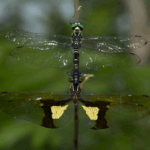The common whitetail dragonfly gets its common name from the white waxy coating that develops on the wings and abdomen of the mature male.
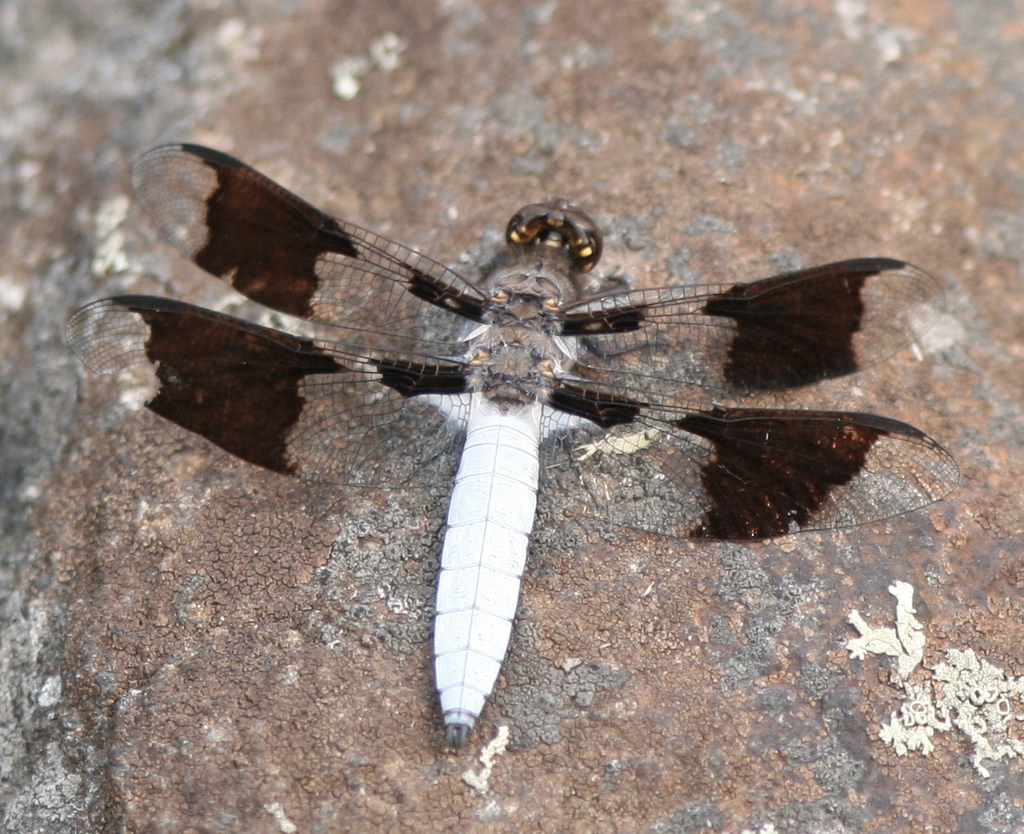
Dragonflies have excellent eyesight. Their compound eyes have up to 30,000 facets, each of which is a separate light-sensing organ or ommatidium, arranged to give nearly a 360° field of vision. Odonates are completely harmless – they do not sting or bite. Indeed, they are beneficial in the same respect spiders and other predators are beneficial – they keep the burgeoning insect population in check. Many of these species prey on each other; I often see dragonflies devouring damselflies.
Dragonflies are among the most ancient of living creatures. Fossil records, clearly recognizable as the ancestors of our present day odonates, go back to Carboniferous times which means that the insects were flying more than 300 million years ago, predating dinosaurs by over 100 million years and birds by 150 million.
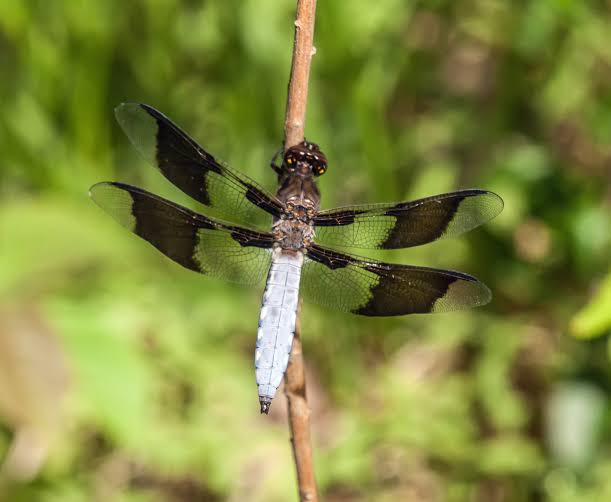
Common Whitetail
Common Name: Common Whitetail.
Scientific Name: Plathemis Lydia.
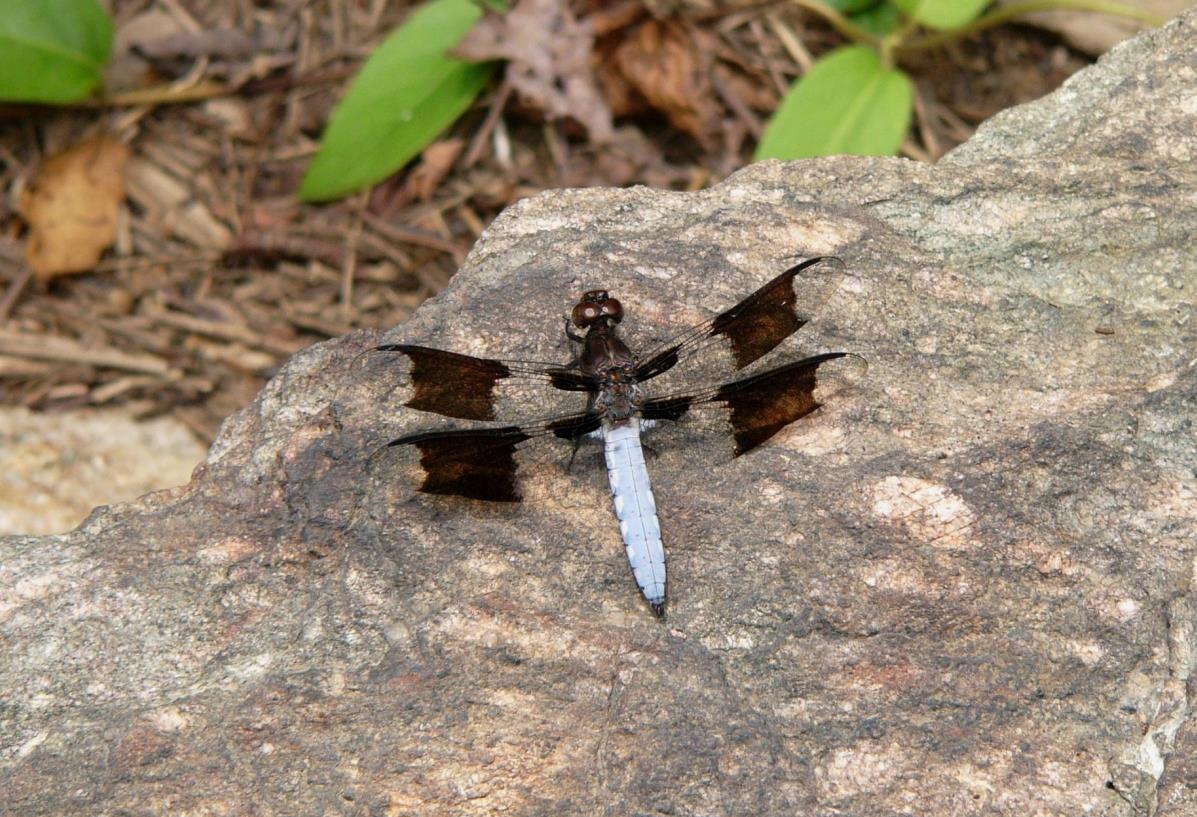
common whitetail habitat
Habitat:Mostfreshwaterhabitats –prefers still,shallow water.
Larvae feed on a wide variety of aquatic insects, such as mosquito larvae, other aquatic fly larvae, mayfly larvae, and freshwater shrimp. They will also eat very small fish and tadpoles.
Adult- The dragonfly will eat almost any soft-bodied flying insect including mosquitoes, flies, small moths, mayflies, and flying ants or termites.
Common Whitetail habitat includes muddy bottomed ponds, lakes, marshes, slow streams and stream pools, as well as stock ponds and rarely even bogs (Dunkle 2000, Nikula et al. 2002, Paulson 2009).
Common whitetails, also known as Plathemis lydia, are medium-sized dragonflies that can be found in many types of aquatic habitats, including:
ponds, lakes, marshes, slow streams, stream pools, stock ponds, swamps, and rivers.
They can also survive in urban areas, such as in parking lot puddles, storm drains, drainage ditches, and polluted canals. Common whitetails are often seen in large numbers, and are an important part of the urban and suburban food chain.
Common whitetails are active during the day and are skilled fliers that can fly quickly, hover, and change direction suddenly to catch insects in the air. They can be found hunting for mosquitoes and other small flying insects over water, and often fly among marsh grasses, rushes, and sedges.
Common whitetails are found throughout the United States and southern Canada, and are one of the most common species in the country. In California, adults are typically active from April to September.
Life cycle
Dragonflies, including Plathemis lydia, spend most of their life cycle as aquatic larvae or nymphs, during which there is up to a 99.9% mortality rate. The two most common sources of mortality during the aquatic stage of life are predation and desiccation. P. lydia then enter the adult stage of life, which only lasts a few weeks. During the adult stage of life, P. lydia mate and select suitable sites to deposit their eggs.
Anatomy
Plathemis lydia are adapted to swift flight that is made possible by the presence of broad wings and powerful muscles that move them. This means that there is a need for a plentiful supply of oxygen in order to work the muscles. In order to meet this oxygen requirement, P. lydia are equipped with a complex tracheal system which belongs to the peripneustic type in which the prothoracic and abdominal stigmata are present but not functional through the larva stage of life. The P. lydia nymph is aquatic, and thus do not use their wings during this period of their life, which accounts for the lack of function of the prothoracic and abdominal stigmata.
Notes from the field– Common Whitetail:Whitetails appear both tame and fearless,gravitating towards many of the same outdoorplaces we find ourselves. Their love of perching onflat, sunny surfaces brings them not only to oursidewalks and pathways, but also our porches,balconies, picnic tables, boats, hats, and even ourinsect nets! I have several photos of both maleand female whitetails basking on my net, justseconds after I laid it on the ground. If you find adragonfly perched on your picnic basket, swingset, park bench or boat deck, it’s probably thegutsy little whitetail.Although the male is hard to confuse with otherdragonflies, the female can be a little tricky. Ittook me a while to feel confident in telling herapart from a female Twelve-spotted Skimmer.White marks on their abdomen edge are the key.Female whitetails have marks that slant and angle(see lower photo). The same marks on femaleTwelve-spots are straight and parallel. Another IDtip has to do with behavior– whitetails usuallyperch low, often on the ground, while twelve-spots rarely do, preferring tall stems and shrubs.Whether it’s perched on rocks alongside a remotemountain trail (title photo), or swarming alongdirt roads and urban sidewalks, this adaptableskimmer is at home just about anywhere with aflat sunny perch, and a few tasty mosquitoes.
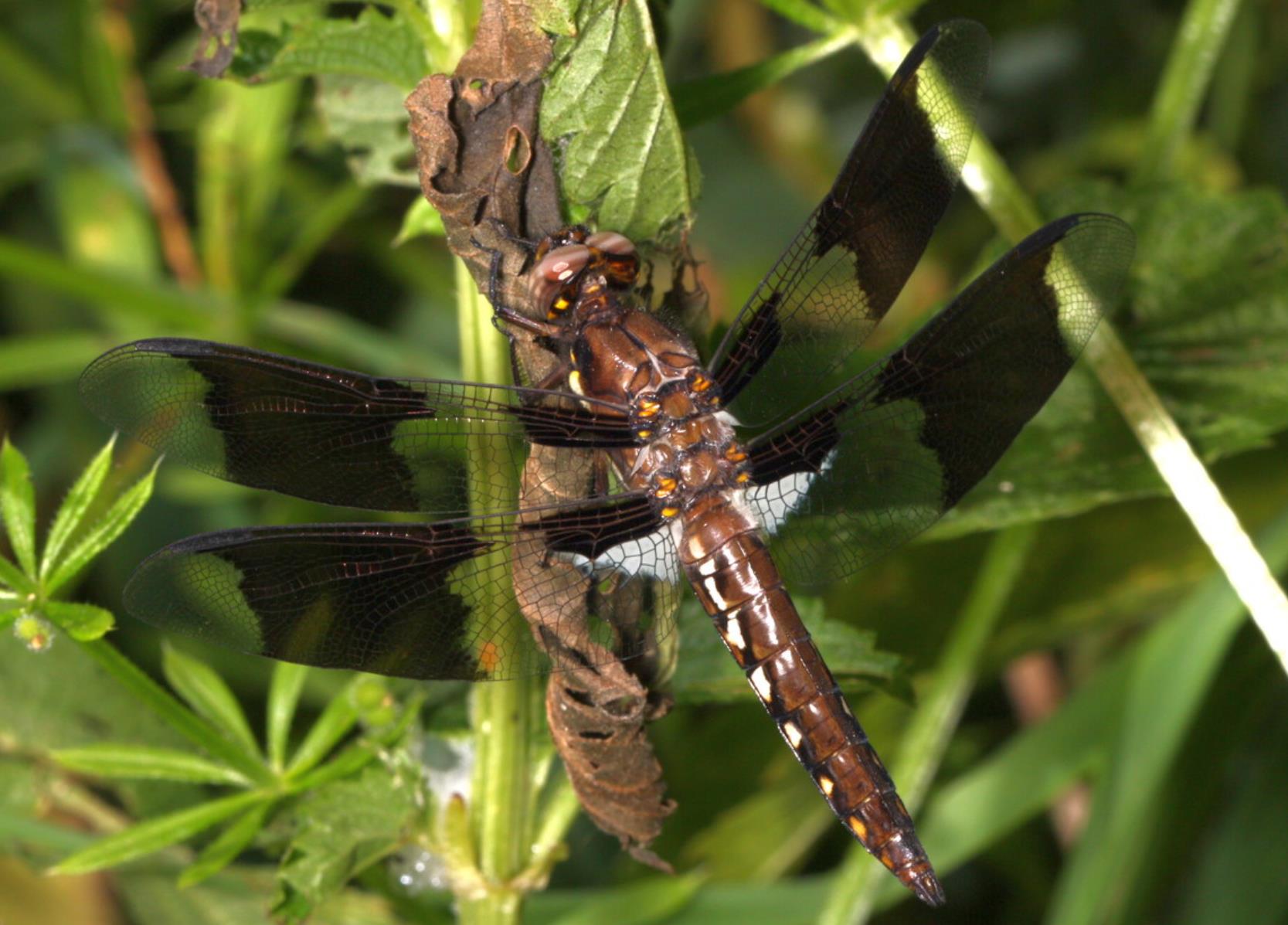
What to look for? Big, handsome, black dragonfly with banded wings and white abdomen and tail! The male and female Common Whitetail are dimorphic with differences in appearance. The male Common Whitetail has large. broad brown or black bands in the outer portion of each wing; the wings of the female are less maculated with three spots – somewhat similar to the Twelve-spotted Skimmer. Their head and face are deep brown as is the robust thorax. The abdomen is broad and stout, almost appearing triangular. The mature male Common Whitetail is recognized by its distinctive white abdomen – enveloped by a white pruinescence. The female Common Whitetail has a brown abdomen, lacking this white, dusty coating.
Where can they be found at Carillon Stonegate Pond? The Common Whitetail will be found here from May to September. Look for them around the water’s edge. As they have a habit of perching on pathways and sidewalks, you may notice the Common Whitetail as you go for your daily walk along the Carillon Stonegate Pond pathways. They also perch on tips of tall grasses surrounding our ponds. Often, they will return to the same perch, providing you with great views of its behavior.
How big are they? Large! The Common Whitetail averages just over one and three-fourths inches in length. And their wingspan is approximately one and one-fourth inches.
What are their flight patterns? Common Whitetails and other dragonflies are expert and agile fliers. They will fly with a burst of speed. Then they may suddenly stop and hover like a helicopter. They will fly straight up and down and make accelerated changes in direction to catch flying insects in mid-air. Common Whitetails are active daytime fliers. They stay low and often fly among the sedges, rushes and marsh grasses along the Carillon Stonegate Pond’s edge.
How else do they behave? Common Whitetails are aggressive, strong fliers entering into numerous skirmishes with other males and intruders. They elevate their distinctive white abdomen above the rest of their body and fly towards an intruder. Territories are established in areas over our ponds that cover approximately 500 square feet. They hunt by perching atop tall plants or branches and scan the surrounding area for unsuspecting prey where they launch an aerial attack to catch it as soon as a potential meal enters their territory.
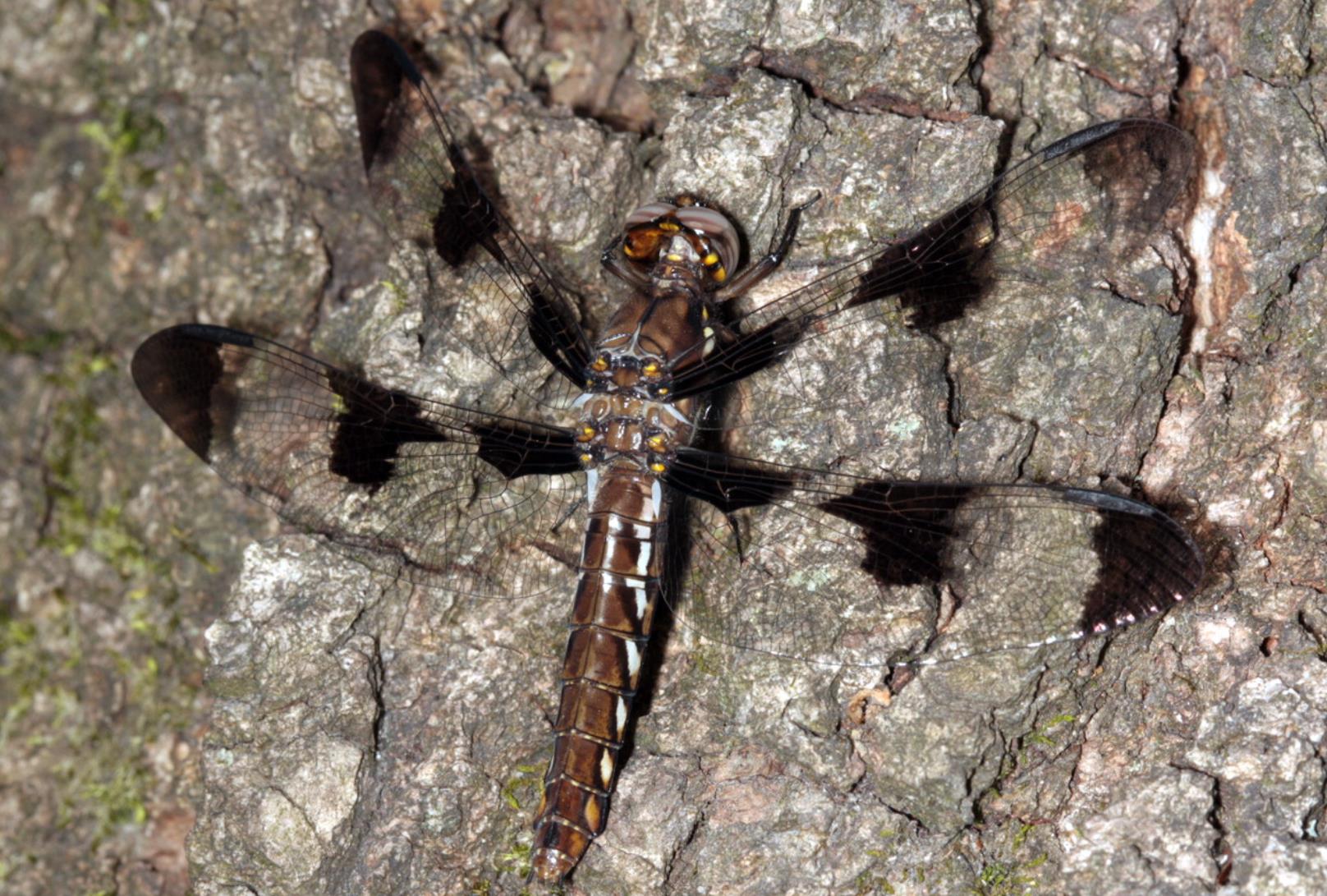
What’s for dinner? Adult Common Whitetails will eat small flying insects like mosquitoes and gnats. During their larval stage, naiads feed on a wide variety of aquatic insects, such as mosquito larvae. In its aquatic larva stage, it is a mosquito’s worst nightmare – first, the aquatic dragonfly larvae zip around the pond eating mosquito larvae and pupae and then, just when the adult mosquitoes get out of the pond, along comes a hungry adult Common Whitetails!
Where do they take up residence? The Common Whitetail is found throughout United States and southern Canada. Common Whitetail tend to prefer open pond and lake shores well exposed to sunlight.
When and where do they breed and nest? Common Whitetails usually mate mid-air, hovering over the water. After mating, the female flies to lay her eggs. She does this by dipping the tip of her abdomen in the shallows of the body of water while hovering just above the water’s surface. She may lay over 1,000 eggs.
Where do they migrate? They do not migrate. Common Whitetail dragonflies overwinter under water while in the nymph stage of their lifecycle.
Do they make any interesting sounds? No.
Interesting Facts About the Common Whitetail:
- Dragonflies of the Family Libellulidae are called skimmers because of the female’s egg laying habits – they skim the surface of the pond laying their eggs.
- Dragonflies were some of the first winged insects to evolve, some 300 million years ago and had wingspans of up to two feet.
- There are more than 5,000 known species of dragonflies, all of which (along with damselflies) belong to the order Odonata, which means “toothed one” in Greek and refers to the dragonfly’s serrated teeth.
- In their larval stage, which can last up to two years, dragonflies are aquatic and eat just about anything – tadpoles, mosquitoes, fish, other insect larvae and even each other.
- At the end of its larval stage, the dragonfly crawls out of the water, then its exoskeleton cracks open and releases the insect’s abdomen, which had been packed in like a telescope. Its four wings come out, and they dry and harden over the next several hours to days.
- Dragonflies are very efficient hunters and catch their insect prey by grabbing it with their feet.
- Some adult dragonflies live for only a few weeks while others live up to a year.
- Nearly all of the dragonfly’s head is eye, so they have incredible vision that encompasses almost every angle except right behind them.
- Dragonflies, which eat insects as adults, are a great control on the mosquito population, consuming up to hundreds of mosquitoes per day.
- Hundreds of dragonflies of different species will gather in swarms, either for feeding or migration.
For more information on the Common Whitetail and sources of information used in this blog (these are the several of the sources that I am using to learn as I blog), please visit Odonata Central, Iowa State University’s Bug Guide, Dragonflies of Northern Virginia and University of Kentucky’s Office of Environmental Programs.
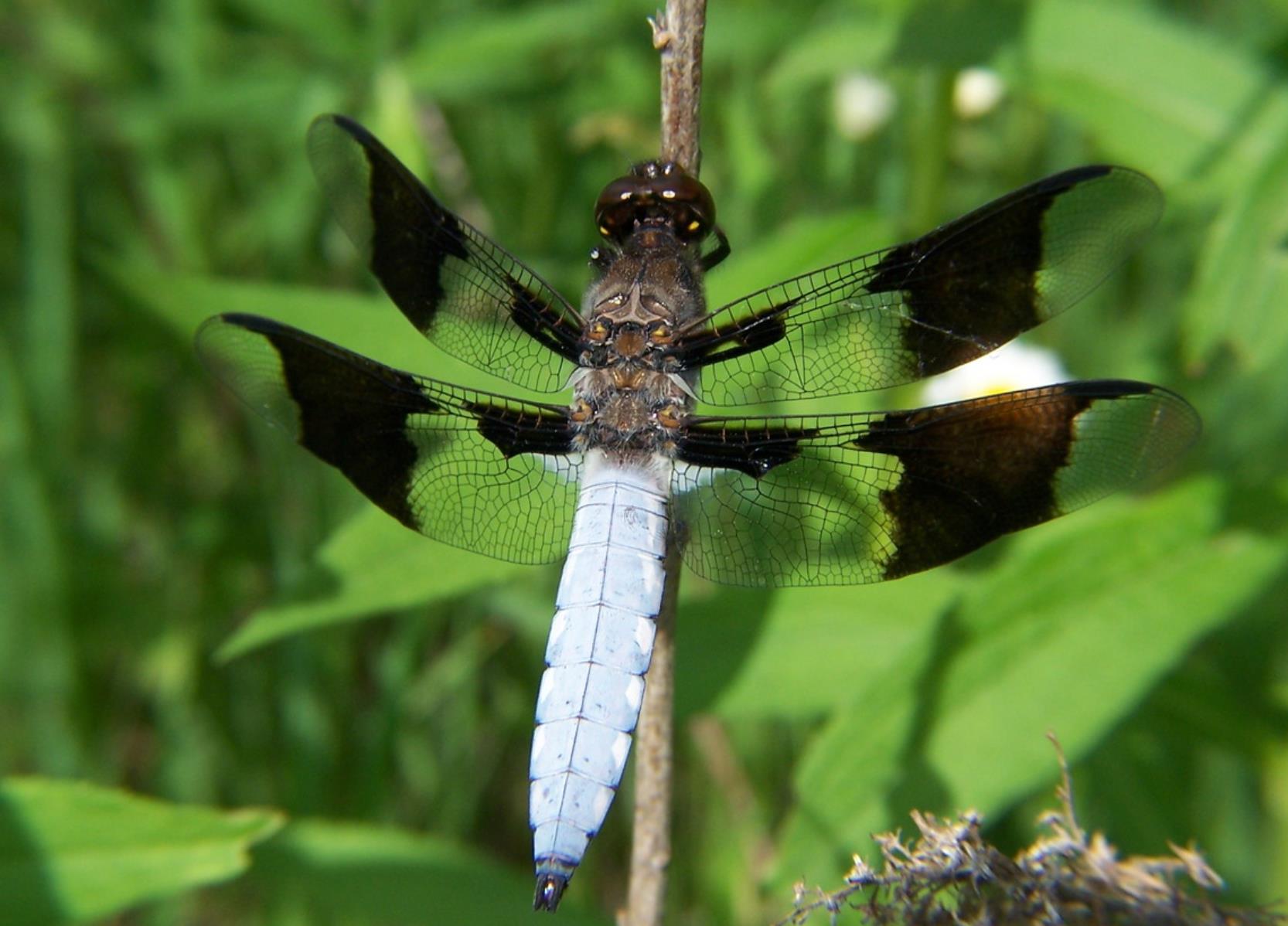
The Carillon at Stonegate community is very fortunate to have a variety of wetland, forest and prairie environments conducive to a variety of birds and other wildlife, insects and plants. Our community and the Kane County Forest Preserve do an exceptional job in maintaining this natural environment – both for the benefit of the birds and wildlife and for our residents to enjoy.


